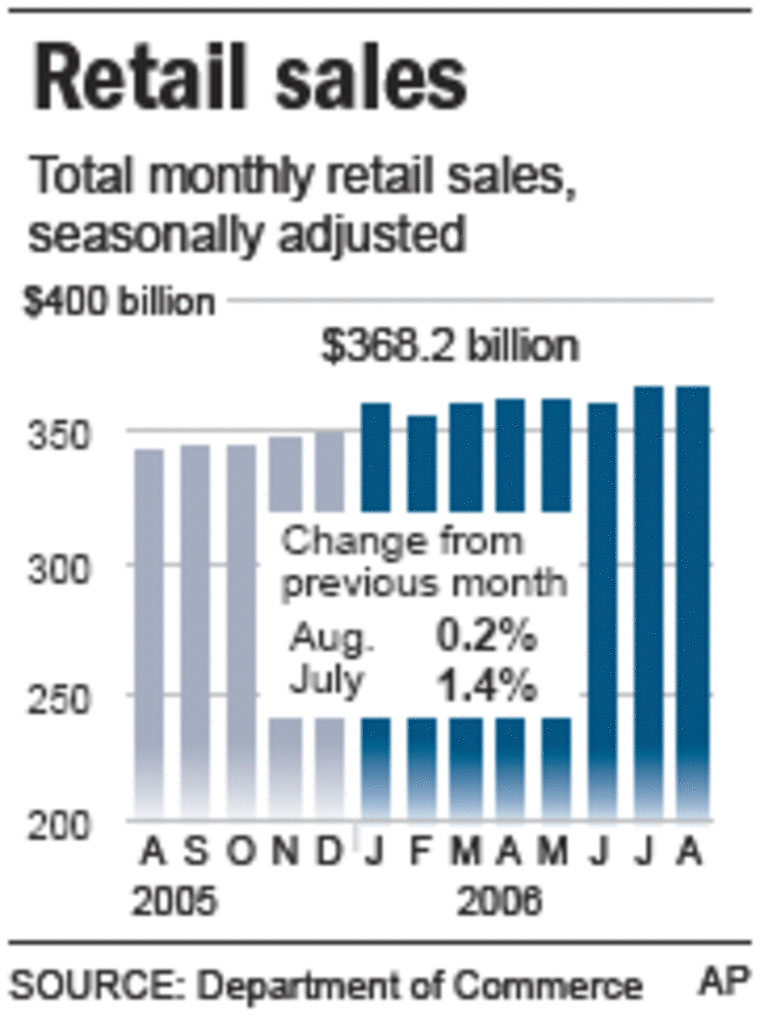Retail sales posted only a modest gain in August as worried consumers got hit anew with sticker-shock at the gasoline pumps.
The nation’s retailers recorded a tiny 0.2 percent increase following a much bigger 1.4 percent rise in July. It was the weakest performance since sales had actually fallen by 0.5 percent in June.
The weakness was led by a 1 percent decline in sales at gasoline stations, which many analysts attributed to motorists deciding to fill up less with pump prices at record levels above $3 per gallon at the beginning of the month.
Retail sales were also held back by a slowdown in car sales, which had surged upward by 4.3 percent in July but posted a more modest gain of 0.4 percent in August.
The tiny 0.2 percent rise in retail sales in August was slightly better than the outright decline of around 0.2 percent that many analysts had been expecting.
On Wall Street, the Dow Jones industrial average lost ground as investors grew cautious ahead of next week’s meeting of the Federal Reserve. The Dow fell 15.93 points to close at 11,527.39.

Consumer spending, which has been the driving force in this economic expansion, slowed dramatically in the spring as Americans were battered by soaring gasoline prices, rising interest rates and a cooling housing market, which made homeowners feel less prosperous and less inclined to spend money.
The overall economy grew at an annual rate of just 2.9 percent in the April-June quarter after turning in a sizzling pace of 5.6 percent in the first three months of the year, reflecting the slowdown in consumer spending, which accounts for two-thirds of total economic activity.
While the slowdown had raised concerns about an outright recession, economists have grown less concerned about that possibility because of the recent retreat in energy prices.
“We are still going to have a slowdown in consumer spending, but it won’t be as big a slowdown as we had first thought,” said David Wyss, chief economist at Standard & Poor’s in New York.
Wyss said he believed the overall economy was growing at a 3 percent rate in the current quarter, about the same as in the second quarter, but that growth would slow to a pace around 2 percent in the October-December quarter as tapped-out consumers are forced to trim spending to build up depleted savings.
Wyss said the slowdown would have been even more severe without the recent drop in gasoline prices, which will leave consumers with more money to spend on other items in coming months.
But some analysts were more optimistic about the impact lower gasoline costs will have.
“Consumer spending is going to explode, probably in September, October and maybe November,” said Stephen Stanley, chief economist at RBS Greenwich Capital.
For July, the weakness in retail sales showed up not only in the slowdown in car sales but in a 0.3 percent drop in sales at furniture stores, which have been hurt by the cooling housing market.
Sales at department stores fell by 0.2 percent while sales at specialty clothing stores were down 0.3 percent.
In other economic news, the Labor Department said that the number of Americans filing new claims for unemployment benefits dropped by 5,000 last week to 308,000, the lowest level in seven weeks.
Analysts said that employers have trimmed their hiring plans in the face of the economic slowdown but have resisted pressures to lay off current workers.
In a third report, the Labor Department said that prices paid for imported goods increased a sharp 0.8 percent in August, reflecting a big rise in the cost of imported petroleum.
It was the fourth big increase in the past five months and even excluding petroleum, import prices were up 0.5 percent in August, raising concerns about inflation pressures stemming from the record level of imports coming into the country.
Fed policymakers meet again next Wednesday. The widespread view is that the central bank will for the second meeting in a row pass up the chance to raise interest rates, preferring to wait and see if 17 rate hikes over the past two years will slow the economy enough to reduce inflationary pressures.